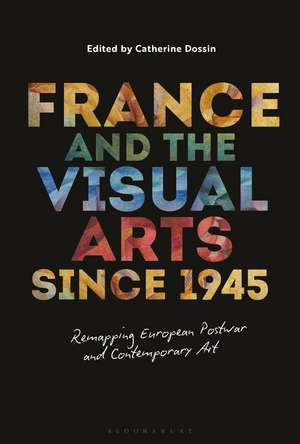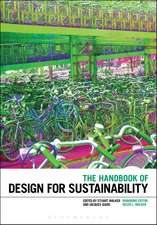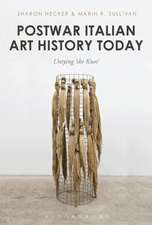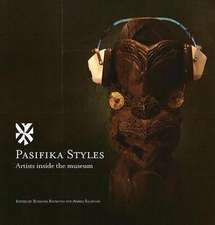France and the Visual Arts since 1945: Remapping European Postwar and Contemporary Art
Editat de Prof Catherine Dossinen Limba Engleză Hardback – 19 sep 2018
| Toate formatele și edițiile | Preț | Express |
|---|---|---|
| Paperback (1) | 231.99 lei 6-8 săpt. | |
| Bloomsbury Publishing – 27 noi 2019 | 231.99 lei 6-8 săpt. | |
| Hardback (1) | 778.03 lei 6-8 săpt. | |
| Bloomsbury Publishing – 19 sep 2018 | 778.03 lei 6-8 săpt. |
Preț: 778.03 lei
Preț vechi: 1115.42 lei
-30% Nou
Puncte Express: 1167
Preț estimativ în valută:
148.88€ • 159.20$ • 124.13£
148.88€ • 159.20$ • 124.13£
Carte tipărită la comandă
Livrare economică 18 aprilie-02 mai
Preluare comenzi: 021 569.72.76
Specificații
ISBN-13: 9781501341526
ISBN-10: 1501341529
Pagini: 304
Ilustrații: 58 bw illus
Dimensiuni: 152 x 229 x 24 mm
Greutate: 0.76 kg
Editura: Bloomsbury Publishing
Colecția Bloomsbury Visual Arts
Locul publicării:New York, United States
ISBN-10: 1501341529
Pagini: 304
Ilustrații: 58 bw illus
Dimensiuni: 152 x 229 x 24 mm
Greutate: 0.76 kg
Editura: Bloomsbury Publishing
Colecția Bloomsbury Visual Arts
Locul publicării:New York, United States
Caracteristici
Features international team of young scholars, whose work provides a new perspective on the place of France and French artists in the history of postwar Western art
Notă biografică
Catherine Dossin is Associate Professor of Art History, Purdue University, USA.
Cuprins
1. Beyond the Clichés of "Decadence" and the Myths of "Triumph": Rewriting France in the Stories of Postwar Western ArtCatherine Dossin, Purdue University, USA2. Art and Communism in Postwar France: The Impossible Task of Defining a French Socialist RealismLucia Piccioni, Center for Italian Modern Art of New York, USA, and Cécile Pichon-Bonin, French National Centre for Scientific Research (CNRS), France3. The Art of Community in Isidore Isou's Traité de bave et d'éternité (1951)Marin Sarvé-Tarr, University of Chicago, USA 4. Their Paris, Our Paris: a Situationist dériveEmmanuel Guy, Parsons Paris, The New School, France5. Pinot Gallizio's Cavern: Re-Excavating Postwar ParisSophie Cras, Université Paris 1 Panthéon-Sorbonne, France6. Agnès Varda's du Côté de la Côte: Place as 'Sociological Phenomenon'Rosemary O'Neill, Parsons - The New School, USA7. Cybernetic Bordello: Nicolas Schöffer's Aesthetic HygieneHervé Vanel, American University of Paris, France8. Nouveau Réalisme in its "Longue Durée": From the 19th Century Chiffonnier to the Remembrance of World War IIDéborah Laks, Deutsches Forum für Kunstgeschichte, France 9. Decelerating Le Mouvement of Paris with Vision in Motion - Motion in Vision of Antwerp: Movement, Time, and Kinetic Art, 1955-1959Noémi Joly, Paris-Sorbonne University, France 10. The Public Art of Jean Tinguely 1959-1991: Between Performance and PermanenceElisabeth Tiso, Graduate Center CUNY, USA11. Jean-Jacques Lebel's Revolution: The French Happening, Surrealism, and the Algerian War Laurel Fredrickson, Southern Illinois University Carbondale, USA12. Reimagining Communism after 1968: The Case of GrapusSami Siegelbaum, UCLA, USA13. Autogestion in French Art after 1968: A Case Study of the Sociological Art Collective Ruth Erickson, Institute of Contemporary Art, Boston, USA14. André Cadere's Disorderly Conduct Lily Woodruff, Michigan State University, USA15. Places of Memory and Locus: Ernest Pignon ErnestJacopo Galimberti, The University of Manchester, UK16. Questioning the Void: Sophie Calle's Archival SubversionsRachel Boate, New York University, USA17. Claire Fontaine, Redemptions Liam Considine, Pratt Institute, USAIndex
Recenzii
[France and the Visual Arts since 1945] makes an invaluable contribution to our knowledge of French art worlds.
Path-breaking, provocative, and richly informative, Dossin's anthology presents a timely reassessment of French art within its complex local and global contexts. Built on incisive research, it challenges conventional art-historical narratives and nationalist clichés. The book will be an essential reference for future mappings of European art's relationships to history, geopolitics and aesthetics.
This fine collection of essays corrects any lingering notion that artistic practices in France were on the decline in the post-war period or that American art history can remain the predominant model. Against a long-standing narrative that locates France's decadence as the pendant to the United States' ascendance, the international group of authors in this collection historicize and contextualize a diverse set of case studies that illuminate the specific French experience; in so doing, they make a compelling argument for writing different history of art, one that simultaneously re-examines the place of Frances in the visual arts since 1945 and questions the genealogies and historiographies that have sustained the authority of American postwar and contemporary art. Such an attempt to expand the canonical narrative has been a long time coming.
This invaluable collection confirms the undeniable richness and diversity of post-war French art. More importantly, it reveals the distinctive political and intellectual commitments of key artists and movements, and helps combat the prejudices of a modernist art history still too often narrated from the vantage point of the United States.
Path-breaking, provocative, and richly informative, Dossin's anthology presents a timely reassessment of French art within its complex local and global contexts. Built on incisive research, it challenges conventional art-historical narratives and nationalist clichés. The book will be an essential reference for future mappings of European art's relationships to history, geopolitics and aesthetics.
This fine collection of essays corrects any lingering notion that artistic practices in France were on the decline in the post-war period or that American art history can remain the predominant model. Against a long-standing narrative that locates France's decadence as the pendant to the United States' ascendance, the international group of authors in this collection historicize and contextualize a diverse set of case studies that illuminate the specific French experience; in so doing, they make a compelling argument for writing different history of art, one that simultaneously re-examines the place of Frances in the visual arts since 1945 and questions the genealogies and historiographies that have sustained the authority of American postwar and contemporary art. Such an attempt to expand the canonical narrative has been a long time coming.
This invaluable collection confirms the undeniable richness and diversity of post-war French art. More importantly, it reveals the distinctive political and intellectual commitments of key artists and movements, and helps combat the prejudices of a modernist art history still too often narrated from the vantage point of the United States.













